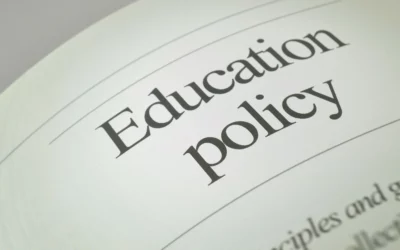
Written by Christine Cooke Fairbanks
April 11, 2024

Anchored at the center of many education reforms is the parent-teacher relationship. AEI scholar Rick Hess has talked about the importance of the parent-teacher “handshake,” a relationship of joint effort and mutual responsibility.
Sadly, politics has seeped into education policy. It has resulted in parents and teachers being pitted against one another, at least in rhetoric if not in fact. Perhaps thinking of parents and teachers engaging in a handshake is a helpful way to combat this without legislation or public policy changes. A handshake may be a good analogy because it suggests a meeting of the minds, true partnership, and practical cooperation.
Particularly in the public school space, this partnership does not allow either party to pass blame entirely to the other for outcomes. There is no scapegoat, only opportunities for either party or both to work on the factors within their scope.
How do we achieve a “handshake,” so to speak, in Utah and beyond? Here are a few key approaches.
Parent side of the handshake
On the parent side of the handshake is a set of responsibilities that teachers cannot do – or cannot do as well as parents. These include directing the education of their children, being involved as parents in school, or helping students with nonschool factors that prepare them for a day of learning.
Parental direction of the education of their children includes the right and the responsibility, protected by the U.S. Constitution, to choose a school or academic path that reinforces the upbringing that parents desire for their children. They can pursue educational options that support their family’s values and build desired capacities in their children.
Parental involvement in school, which has known positive impacts on student outcomes, can include actions like keeping up with communications from the school or teacher; asking questions about coursework, due dates or expectations; attending in-school opportunities like parent-teacher conference; volunteering in the classroom when needed; or reinforcing what is taking place in school. In short, parental involvement means assisting or understanding what the teacher has decided for their classroom, but it does not mean dictating that teacher’s choices.
Parents also have the responsibility to help students prepare via nonschool elements that affect learning before ever walking into class. Where possible, this includes things like helping kids get proper sleep and eat healthy foods, or finding ways to get kids to the school doors each day.
Recent data suggests that it is not just the number of hours of sleep, but the regularity of sleep hours that impacts academic outcomes for adolescents. While not all parents have the same opportunity to directly help students with these tasks, many do. They could start by creating routines where kids go to bed and wake up at consistent hours.
Chronic absenteeism continues to be an alarming problem in Utah and beyond. Some schools have seen the number of chronically absent students quadruple since the pandemic, which has effects on student achievement. While this is a complex problem with many unknowns, certainly some of it can be addressed by parents.
According to a recent study, caretakers of children who are chronically absent underestimate their children’s absences, and less than half of those parents report being concerned about their students being chronically absent. Parents can start by better understanding school policies for keeping kids home (and when to send them to school) when they have mild symptoms, being up to date on policies that define tardies versus absences, or simply keeping count of how many days a child has been absent from school already may encourage parents to ensure kids attend school.
Completing due diligence before making decisions for their child’s education is another part of the handshake. Never have there been so many education choices for parents or information about education options (including dashboards, reviews, and word-of-mouth recommendations). Parents ought to ask questions about the best options for their child, including curriculum, pedagogy and philosophy, and then make decisions based on that information.
Teacher side of the handshake
Teachers have an important set of responsibilities they owe to parents and students, including communication and transparency.
Communication between educators and parents has never been easier, thanks to technology. It has empowered teachers to give information nearly constantly to parents and students both inside and outside the classroom. Platforms like Canvas allow teachers to easily share with students and parents what assignments are being given. Likewise, platforms like Class Dojo seek to create “communities” between families and teachers through direct messaging, photos or videos throughout the day.
There are even apps specific to parent-teacher communication, like Klassly, which offers calendars, video conferencing, homework tracking, parent opinion polling and more. Another called Bloomz, a parent communication app, has won awards for its helpfulness in connecting parents and teachers through attendance management and permission slips and forms, as well as robocalls to parents. Notably, although social media has proliferated, a 2018 survey parents preferred information given by email, text or calls over social media.
Harnessing artificial intelligence for the benefit of teachers, including creating emails or grading papers, is gaining recognition.
Educators ought to keep in mind that while their classroom choices are their purview as professionals, the students are the purview of parents. Actively inviting parents in, offering answers to reasonable questions, or sharing recommendations might be a way to bolster trust between teachers and parents.
Speaking of trust, curriculum transparency is another way that educators can participate in the parent-teacher handshake. Offering up as much information as possible to parents about what they’ll be teaching in a given course shows a willingness to partner with parents, who may react with more forthcoming trust, cooperation, and support for classroom learning, to the benefit of student achievement.
Conclusion
The parent-teacher handshake is a helpful way to think through the relationship that ought to exist between the two groups. Not all reforms require lawmaking. Making changes in culture, including how we view relationships between education stakeholders, is a key way to achieve them.

Insights: analysis, research, and informed commentary from Sutherland experts. For elected officials and public policy professionals.

- Rick Hess’ concept of a handshake is a helpful analogy for understanding a healthy relationship between parents and teachers.
- Parents can and should direct their child’s education, be involved in their child’s schooling, support children in nonschool factors that impact learning, and get informed before making choices.
- Teachers can communicate with parents using a growing list of technologies and seek to be transparent about curriculum choices.
Read More
Education policy to consider during the 2024 election season
Here’s a look at what each presidential candidate is likely to focus on in education, given their track records and campaign platforms.
Ignoring the text of the Constitution is a mistake
A written Constitution is entirely superfluous if the document is simply meant to give the people what they want.
What you need to know about election integrity
It should be easy to vote and hard to cheat. This oft-quoted phrase has been articulated as a guiding principle by many elected officials wading into voting and election policy debates in recent years. So why has this issue been so contentious, and what’s the solution?


